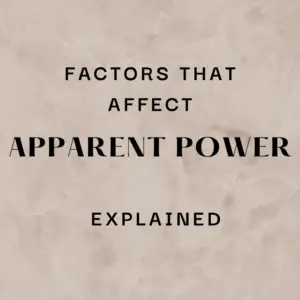Have you ever wondered why electrical equipment like transformers, generators, and motors are rated in terms of “apparent power i.e. KVA”?
This is because apparent power is an important parameter in power transmission and distribution systems that helps to determine the capacity of the electrical equipment required to handle the load.
In this article, we will explore the significance of apparent power in power transmission and distribution, and how it is related to other parameters like real power and reactive power.
Table of Contents
What is Apparent Power?
Before we dive into the significance of apparent power, let’s first define what it is. Apparent power is a measure of the total power in an AC circuit and is given by the product of the voltage and current in the circuit.
Mathematically, it is represented by the equation S = VI, where S is the apparent power, V is the voltage, and I is the current.
Unlike real power, which represents the actual amount of power consumed by a load, apparent power takes into account the effects of reactive power, which is the power used by inductive and capacitive loads to create magnetic and electric fields respectively.
Reactive power does not contribute to the actual work done by a load but is required to maintain the voltage and current levels in the circuit.
Significance of Apparent Power in Power Transmission and Distribution
Now that we have a basic understanding of what apparent power is, let’s explore its significance in power transmission and distribution. Here are a few key points to keep in mind:
Apparent power determines the capacity of electrical equipment:
The apparent power rating of electrical equipment like a transformer or a generator is a measure of the maximum load that it can handle. In other words, it determines the capacity of the equipment to handle both real and reactive power.
Apparent power is used to size conductors and other components:
In power transmission and distribution systems, the size of the conductors and other components like switches, breakers, and fuses is determined based on the apparent power of the load.
This is because the current in the circuit is directly proportional to the apparent power, and the size of the conductors and other components must be able to handle this current.
Apparent power affects system efficiency:
Power transmission and distribution systems are designed to minimize losses due to resistance in the conductors.
However, reactive power can cause additional losses in the system, reducing its overall efficiency.
By understanding the apparent power and reactive power requirements of the load, the system can be designed to minimize losses and improve efficiency.
Real Power, Reactive Power, and Power Factor
We mentioned earlier that real power and reactive power are related to apparent power. Real power represents the actual amount of power consumed by a load, and is given by the equation P = VIcos(θ),
Where:
P is the real power, V is the voltage, I is the current, and θ is the phase angle between the voltage and current.
Reactive power, on the other hand, represents the power used by inductive and capacitive loads to create magnetic and electric fields and is given by the equation Q = VIsin(θ).
Reactive power does not contribute to the actual work done by a load but is required to maintain the voltage and current levels in the circuit.
The power factor is a measure of the ratio of real power to apparent power and is given by the equation PF = P/S.
A power factor of 1 indicates that all the power in the circuit is being used for useful work, while a power factor of less than 1 indicates that some of the power is being lost due to reactive power.
Don’t Leave Empty-Handed!
Install my Free Android App on Google Play:
Electrical Cables Most Common Tables “Cables Tables”
And, my Electrical Calculations App “Fast Electrical Calculator”
Discover more great content by subscribing to My channel
Looking to stay ahead of the game in the world of electrical engineering? Subscribe to my YouTube channel and gain access to exclusive content you won’t find anywhere else!
The staff I recommend
(Amazon Affiliate Links to products I believe are high quality):
- Economy 120 Volt/60Hz AC Power Source – Step-Down Voltage & Frequency Converters 1800W
- UNI-T Digital Multimeter Tester UT139C
- 50-Amp Extension Cord for RV “100ft”
- Voltage Stabilizer 110/220v
- Hair Dryer “best selling“
- TOSHIBA EM131A5C-BS Countertop Microwave Ovens
Disclaimer: This contains affiliate links to Amazon products. I may earn a commission for purchases made through these links.

